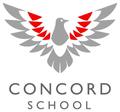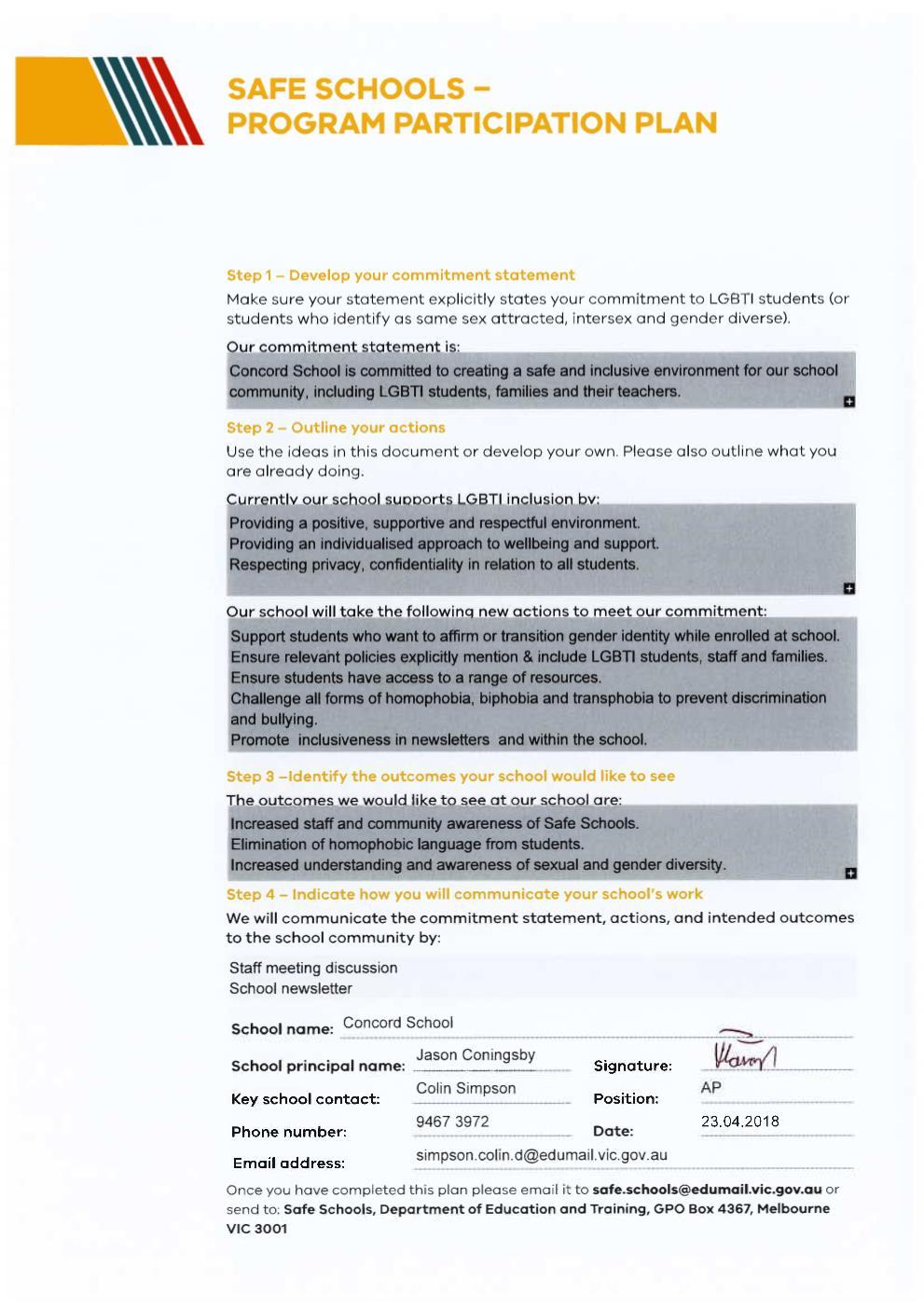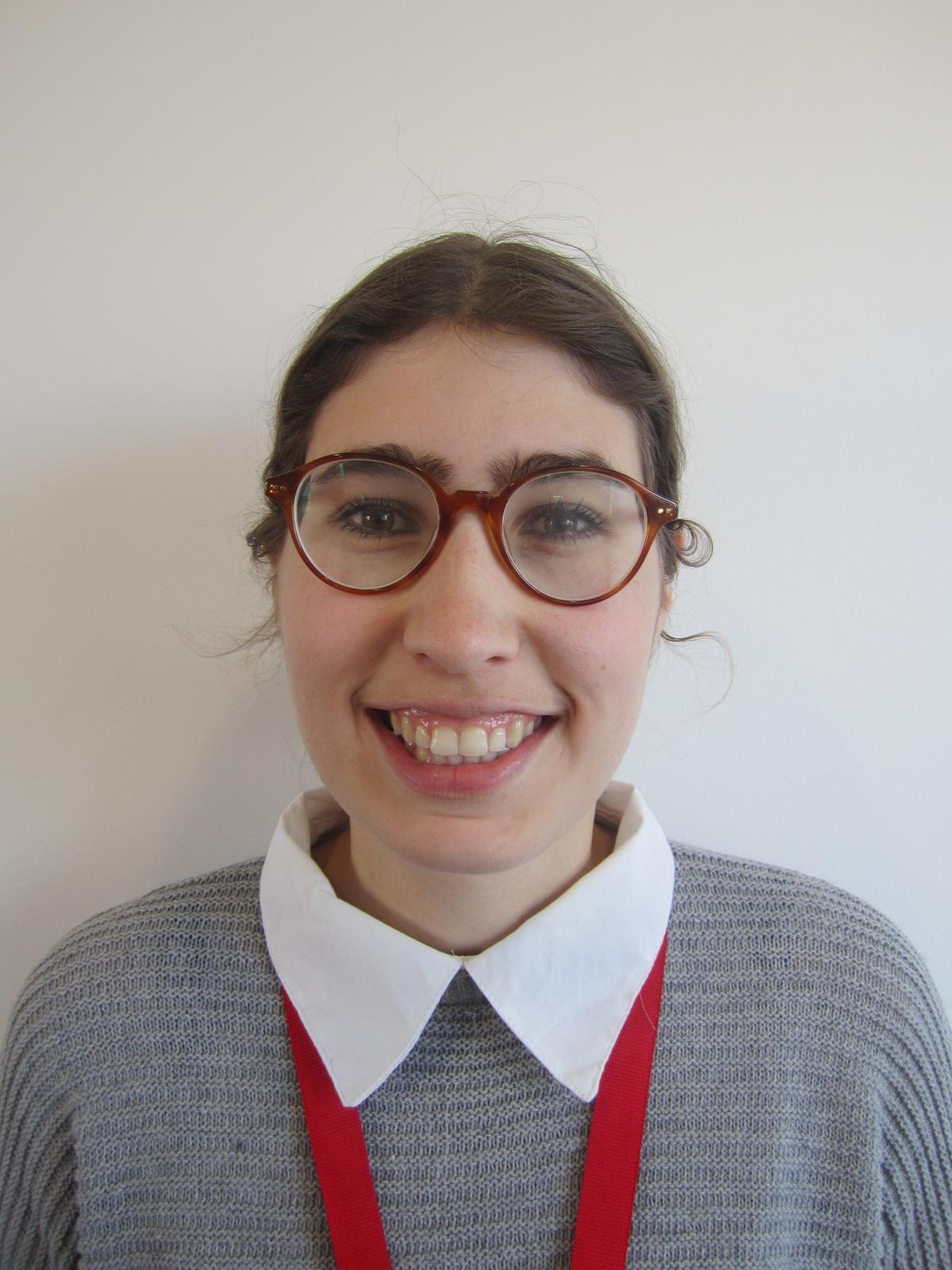Student Wellbeing

Safe Schools
The Victorian Government has established the Safe Schools program to ensure schools are safe places for all students, including lesbian, gay, bisexual, transgender and intersex (LGBTI) students. The program helps schools foster a safe environment that is supportive and inclusive of LGBTI students.
Safe Schools recognises that creating a safe and inclusive environment is key to tackling bullying and harassment, and preventing suicide and self-harm.
Safe Schools is not a subject taught in the classroom and it is not a part of the curriculum. It is a program for principals, teachers and school communities.
The Victorian Government has committed to expanding the program to all government secondary schools by the end of 2018.
The Concord School Council is supportive of this initiative and has agreed to the following plan:
Myths and facts
From time to time, ill-informed and false information is circulated about the Safe Schools program.
Myth: The Safe Schools program is a compulsory part of the school curriculum.
Fact: Safe Schools is not part of the Victorian Curriculum – it’s a commitment that schools make to be inclusive places for all students, including LGBTI students. The Department of Education and Training provides information, resources and professional learning that have been developed by experts for school staff to use as they see fit to prevent discrimination against LGBTI students.
Myth: The Safe Schools program is teaching sex education and/or sexual practices to students, including material that is not age-appropriate.
Fact: Safe Schools is not a sex education program, nor does it teach sexual practices. The Safe Schools program simply seeks to create safe and inclusive environments for LGBTI students. Resources provided by the Department of Education and Training to help deliver the program are developed by experts and carefully selected to ensure they are appropriate for the ages of students using them.
Myth: The Safe Schools program encourages students to question or change their gender or sexuality.
Fact: Nothing about the Safe Schools program encourages students to question or change their gender or sexuality.
Myth: The Safe Schools program teaches radical gender theory.
Fact: Safe Schools does not teach radical gender theory. It is simply a program to help schools and students understand and respect that people should not be discriminated against for any reason - including gender and sexual diversity.
Myth: The Safe Schools program teaches there are 63 different genders.
Fact: The Safe Schools program does not teach this.
Myth: The Safe Schools program encourages use of props.
Fact: The Department of Education and Training provides evidence-based information, written resources and professional learning for school staff to use as they see fit to support schools to prevent, and respond to, discrimination against LGBTI students. These resources do not include props.
Myth: The Safe Schools program asks students to role play same-sex relationships.
Fact: There are no role playing or acting exercises in the optional Safe Schools teaching resources. Rather, one interactive exercise invites students to imagine themselves in someone else’s shoes. This exercise is designed to build empathy and understanding of others. Resources provided by the Department of Education and Training are developed by experts and carefully selected to ensure they are age appropriate.
Myth: The Safe Schools program isn’t a real anti-bullying program.
Fact: It is a sad reality that LGBTI young people are more likely to be bullied at school than elsewhere and this has a major impact on their educational outcomes. Safe Schools provides information and resources to schools to raise understanding and awareness of sexual and gender diversity. The program assists schools to have conversations with students about mutual respect and understanding towards each other despite differences in their culture, beliefs, sexuality or gender. By doing so, young people feel safer at school and are provided with an environment where they can be happy, confident and resilient.
Myth: All government and non-government schools are forced to join the program.
Fact: The Victorian Government has committed to expand the Safe Schools program to all government secondary schools by the end of 2018. These schools are free to implement the program in a way that best suits their students and community. Other schools, including primary schools and non-government schools, are able to access the Safe Schools information and resources as they see fit and request support where they need it.
Myth: Parents are not given an opportunity to consent to their child’s participation and the program disregards the wishes of parents who do not want their children to participate.
Fact: Individual schools decide how to implement the Safe Schools program at their school, based on their local context and the needs of their school community. This is often done in consultation with students, school council and the broader school community. The program does not impose specific requirements for student participation but does ask all school community members to demonstrate the school’s values. The Department of Education and Training encourages parents to discuss any concerns directly with the school principal. Within any school community there is always a diversity of views represented and schools take those views into account when working with children and families.
Myth: Students are told not to discuss the content of the Safe Schools program with people outside of school, including their parents.
Fact: This is not true. Students are encouraged to discuss what they learn at school with their families and parents. Schools are encouraged to engage families and the broader school community in their implementation of the Safe Schools program.
Myth: The program promotes and teaches children to undertake behaviour such as chest-binding and cross-dressing.
Fact: The program does not promote chest-binding or cross-dressing. The program provides information and resources to schools to raise understanding and awareness of sexual and gender diversity. Many LGBTI students feel uncomfortable about seeking support or affirming their identity and providing guidance and advice about these processes can reduce fear and anxiety in dealing with this. For many people, the question of their gender or their sexuality is straightforward; however, for some it is more contested as they don’t fit neatly into the ‘norm’. The Safe Schools program is solely aimed at helping children and young people understand that not everyone is the same and to respect this.
Myth: The Safe Schools program promotes cross dressing.
Fact: The Safe Schools program does not promote cross-dressing. The Safe Schools program seeks to ensure all children and young people feel safe, happy and comfortable at school.
Myth: Schools are overstepping their role by participating in the Safe Schools program.
Fact: Making sure our school environments are safe and free from discrimination and harassment is a requirement under Australian and Victorian anti-discrimination laws. The role of a school is to equip its students to lead healthy and productive lives, to not only achieve academically but also to be happy, healthy and resilient. Social and emotional learning is a key aspect of development for young people.
Myth: Respectful Relationships and the Safe Schools program are the same.
Fact: Respectful Relationships and Safe Schools are two very different initiatives. The Victorian Royal Commission into Family Violence recommended Respectful Relationships be introduced to all government schools (Recommendation 189). The Respectful Relationships initiative takes a whole of school approach, looking at practices and policies to build a culture of respect and equality. It also looks at topics like coping with stress and problem solving, helping students excel at school.
Meet The New Discovery Centre Technician
- Ashley Butler
What is your role at Concord School?
Discovery Centre Technician
Provide us with a ‘snapshot’ into your daily routine at Concord School:
My role is to coordinate bookings within the centre, to support student learning and engagement and creating and designing the interactive displays.
What do you love most about working at Concord School?
Geting to meet all the students, being creative, using the amazing technology in the centre
Fast Seven
Favourite Food: Pizza
Favourite Movie/TV Show: Stranger Things
Favourite Music: Indie Rock
Things I hate the most: Olives
Hidden Talent or Something We May Not Know About You: I am half Canadian
Favourite Sporting Team/Athlete: Melbourne Storm
If You Could Pick Any 3 People as Dinner Guests, Who Would They Be and Why?
Cleopatra - to chat about ancient history
Leonardo DiCaprio - to talk movies
Sir David Attenborough - nature chats
Colin Simpson and Kath Moore
Assistant Principals


